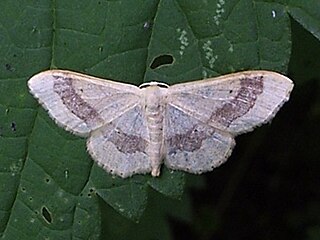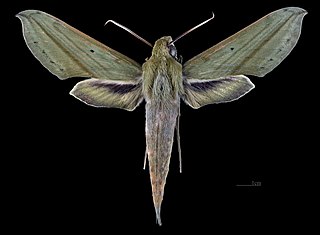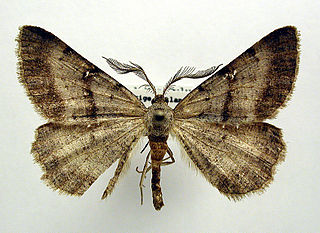
The small fan-footed wave is a moth of the family Geometridae. The species was first described by Johann Siegfried Hufnagel in 1767.

The small dusty wave is a moth of the family Geometridae first described by Franz von Paula Schrank in 1802. It is found throughout Western, Central and Northern Europe. In the north, its range extends as far as Denmark and southern Scandinavia. In the east its range extends as far as Russia. Idaea seriata is replaced by the subspecies Idaea seriata canteneraria, from the north-east of Spain and the central and eastern Mediterranean to the Crimean peninsula, while the western Mediterranean and the Balearic Islands are inhabited by the sister species Idaea minuscularia. Outside Europe it is found in eastern Algeria, Tunisia, Turkey, Cyprus, the Caucasus and the northwest of Transcaucasia. In Morocco and western Algeria, it is replaced by the sister species Idaea minuscularia. In the British Isles it is common in England and Wales but is only found in the eastern half of Scotland and it is rare in Ireland.

The riband wave is a moth of the family Geometridae. The species was first described by Carl Linnaeus in his 1758 10th edition of Systema Naturae.

The mottled pug is a moth of the family Geometridae. The species was first described by Jacob Hübner in 1813. It is found across the Palearctic region apart from around the Mediterranean Sea. It is common in the British Isles apart from Scotland where it is rather local.

The currant pug is a moth of the family Geometridae. The species was first described by Henry Doubleday in 1856. It is found across the Nearctic and Palearctic regions. Its occurrence extends eastwards from Ireland, across Europe to the Near East, the Urals, the Ussuri region and on to the island of Sakhalin. In the Pyrenees and the Alps it rises to altitudes of 1500 and 1800 metres respectively.

The common pug is a moth of the family Geometridae. It is a common species across the Palearctic region, including the Near East and North Africa. It ranges from the Atlantic coast of Ireland and Portugal across Europe, the Middle East and Central Asia to the Russian Far East (Priamurje) and Korea.

The juniper pug or juniper looper is a moth of the family Geometridae. The species was first described by Michael Denis and Ignaz Schiffermüller in 1775. It is found throughout the Palearctic and in the Nearctic.

Idaea dimidiata, the single-dotted wave, is a moth of the family Geometridae. It is a Holarctic species.

Idaea muricata, the purple-bordered gold, is a moth of the family Geometridae. It was first described by Johann Siegfried Hufnagel in 1767 and is found in the Palearctic.

The brindled pug is a moth of the family Geometridae found in Europe including the British Isles as well as further east to the Baltic States, Armenia, Turkey and the Caucasus. South it reaches North Africa.

Idaea fuscovenosa, the dwarf cream wave, is a moth of the family Geometridae. It is found in the Palearctic.

Idaea straminata, the plain wave, is a moth of the family Geometridae. It is found in Europe including West Russia and Balkans.

Jodis lactearia, the little emerald, is a moth of the family Geometridae. The species was first described by Carl Linnaeus in his 1758 10th edition of Systema Naturae. It is found throughout the Palearctic realm, from Ireland to Japan.

Eupithecia denotata is a moth in the family Geometridae. The species can be found across the Palearctic from western Europe to Central Asia and China.

Eupithecia pygmaeata, the marsh pug, is a moth of the family Geometridae. It is known from most of Europe, western and southern Siberia, the Russian Far East, northern Mongolia and North America .The species primarily colonizes floodplain and disused forests, bogs, river banks and marshy meadows. E. pygmaeata reaches up to 1800 meters in South Tyrol.

Eupithecia valerianata, the valerian pug, is a moth of the family Geometridae. The species was first described by Jacob Hübner in 1813. It is found from Great Britain, through central Europe to western Russia, Belarus and northern Iran.

Idaea flaveolaria is a moth of the family Geometridae first described by Jacob Hübner in 1809.

Xylophanes elara is a moth of the family Sphingidae first described by Herbert Druce in 1878. It is known from Paraguay, Suriname, Venezuela, Bolivia and Brazil.

Selidosema brunnearia, the bordered grey, is a moth of the family Geometridae. The species was first described by Charles Joseph Devillers in 1789. It is found in central and southern Europe, Asia Minor, Transcaucasia and North Africa.
Idaea poecilocrossa is a moth of the family Geometridae. It is found in northern Madagascar and on the Seychelles.




















